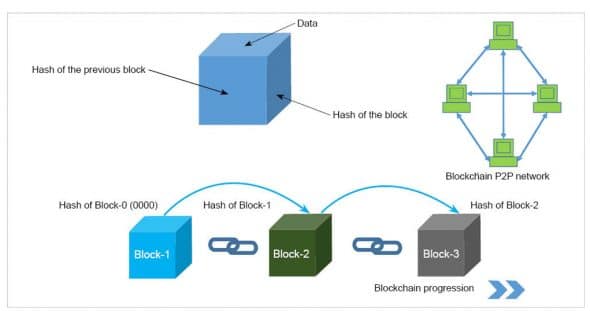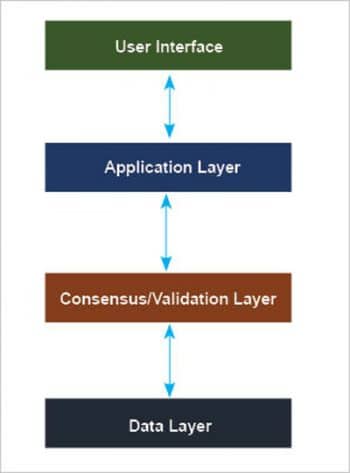As the name suggests, blockchain is a chain of blocks that carry data (usually about any transaction) and hashes (created for the linked blocks). It is a unique method of storing data in a distributed manner, which also makes it a very secure system. This is precisely why a blockchain can help in many ways during a pandemic.
It was Stuart Haber and W. Scott Stornetta who first described a way of storing data using a chain of blocks linked together with cryptography. However, blockchain technology was improved by Satoshi Nakamoto in 2008 and implemented as a cryptocurrency called Bitcoin. Apart from Bitcoin, many financial services firms, logistics companies and social media giants are now trying to implement blockchain for their products and services.

Blockchain architecture
A blockchain consists of blocks (a virtual data container) that contain data and a hash. The hash is created based on the data stored in the block, and this is done with the help of a hash creation algorithm. The block also contains the hash of its previous block. A block is created whenever any new data is stored in the blockchain network or any transaction is done (in case of cryptocurrency).
Blockchain uses a peer-to-peer (P2P) network and whenever a new block is created, it is linked with the previous one in the network by storing the hash of the previous block in it. This makes a blockchain secure, because if the data of any block is tampered with, then it will change the hash of that block and it will no longer be connected with the blockchain.
Blockchain also uses a timestamp for every new data stored in a block and that prevents it from being tampered with or copied. While timestamping, the exact time of the stored data is stamped (stored) inside the block along with the data. If any change is made to the data, then the time also changes. This feature of blockchain makes it secure for cryptocurrencies, because if any transaction data is tampered with, then the time of transaction is also changed. Almost any kind of data can be stored in a blockchain but in the case of cryptocurrencies, data related to the user and transaction data are mainly stored, which is also known as a distributed ledger. Cryptocurrencies like Bitcoin use a concept called ‘proof of work’, which is carried out usually by Bitcoin miners, in order to validate any transaction over the blockchain network.
Bitcoin miners use powerful computing machines (ASIC processors) to solve certain mathematical problems in a network. Such machines are like supercomputers, specially designed for processing data over a Bitcoin network. The efficiency of a mining machine is measured in terahashes and today, a speed of at least 12 terahash/sec is required for mining Bitcoins. The more powerful the miner’s system is, the higher the chances of solving the math problems, and the miner who solves it first, gets the chance to create the next block and validate any transaction on the Bitcoin network.
However, the proof-of-work (PoW) concept requires a lot of computing power, and the ASIC machines use a lot of electrical power too. Therefore, some cryptocurrencies use proof-of-stake (PoS), where the creator for the next block is randomly chosen based on the wealth and age (i.e., the stake); but such cryptocurrencies are more vulnerable to fake stake attacks, because the attacker can cash an affected node by using very little or no stake.
Blockchain layers
A blockchain operates mainly through four layers – the user interface (UI) layer, the application layer, the consensus/validation layer and the data layer.

The UI layer is the topmost one, and it helps the user interact with the blockchain network. The application layer is the second one, and any app that uses a blockchain operates in this layer. Then comes the consensus/validation layer. The instructions sent by the apps are validated in this layer by the algorithms of the blockchain network and in the case of cryptocurrencies, proof-of-work (PoW) and proof-of-stake (PoS) work in this layer. The final layer is the data layer, where the processing of data, like the storage and retrieval of data from the blocks, is done.
Using a blockchain during a pandemic
Blockchain can be very useful in many ways during a pandemic like COVID-19, while also being used for cryptocurrency, supply chain management (SCM) and infection tracking. As blockchain seems more reliable and secured, using a blockchain network for COVID-19 can help people manage their lives and also control the pandemic.
- Cryptocurrencies: Using cryptocurrencies based on blockchain during and after COVID-19 can help people make financial transactions that are reliable and flawless. As the coronavirus can also be transmited through currency notes and since social distancing is the primary preventive measure for COVID-19, using cryptocurrencies like Bitcoin can help control the pandemic. When compared with other digital payments like debit/credit cards, electronic fund transfers (EFT)/wire transfers and online wallets, cryptocurrencies on blockchain networks are more reliable and less prone to hacking. Moreover, centralised online payment services could go down because of a technical problem or virus attack, but as a blockchain is always a decentralised network, cryptocurrencies like Bitcoin are less vulnerable to such problems. Maybe because of such benefits, the Supreme Court has lifted the ban on Bitcoin in India, which was imposed by the RBI in 2018.The value of one Bitcoin has remained above US$ 5000 (₹ 400,000) for the last one year and reached its highest value (US$ 12,927.40) on June 26, 2019. One can buy and trade Bitcoins in India through various trading companies like BuyUcoin and Zebpay. Bitcoin uses a Secure Hash Algorithm (SHA) for its blockchain network and, as the name suggests, it’s a secure algorithm that prevents any kind of hacking attacks. Apart from Bitcoin, one can also trade other cryptocurrencies like Bitcoin Cash, Ethereum and Litecoin on such platforms. However, not all cryptocurrencies use proof-of-work (PoW). Currencies like Peercoin, Nxt and PotCoin use either proof-of-stake (PoS) or both. As PoS is not as reliable as PoW, Bitcoin is much more reliable when compared with other cryptocurrencies that use only proof-of-stake (PoS). Facebook is planning to launch its own digital currency called Libra, which will use blockchain for any transaction and is based on an open source model.
- Supply chain management (SCM): The delivery of essential items like food and medicines is important during any pandemic and it’s SCM that makes this possible. SCM is the process of keeping track of goods and inventories in a way that could help the logistics team to deliver items on time. With the help of a good SCM system, one can get the transit information of a shipment and track it from point to point. Artificial intelligence (AI) can also help to control the SCM to get better results and it requires less human effort. However, any SCM requires storage of data in a system like a centralised server or cloud storage, but such systems could be vulnerable to virus or hacking attacks. A fraudulent interception of any shipment can happen on a centralised SCM system. As blockchain is always decentralised, no such fraudulent activity can happen easily on a SCM that uses a blockchain network. During a pandemic like COVID-19, there is a need for essential goods around the globe and this demand can only be fulfilled by reliable logistics, backed by a SCM system that uses blockchain. Many logistics companies like Maersk, FedEx, DHL and UPS are using blockchain for their operations.
- Infection tracking: During a pandemic, tracking individuals who are infected is very important and this is done with the help of various screening processes. For COVID-19, the screening for infection is done at various entry points like airports and railway stations using thermal scanners. Then the infected person is sent into quarantine. These quarantined people are digitally marked through their smartphones. That’s why some mobile apps can help to identify people who are already quarantined or diagnosed as having COVID-19. Apps like Aarogya Setu can help people maintain social distance and detect any infected person within close range. Such an app uses Bluetooth and GPS to detect any infected person who is also using the same app. Some apps can even tell which hospitals will admit COVID-19 patients and how many beds are available. However, such apps use a centralised or a cloud based network but are not always reliable. A blockchain network that stores data about COVID-19 patients is safe and reliable. As every block in a blockchain is tamper-proof, the data stored on such a network is always safe and secure. As blockchain networks are less vulnerable to fraudulent attacks, the infection tracking information stored on such networks is not affected in any manner. Moreover, most infection tracking systems used by the government are centralised and cannot be used outside the country. Such systems have limitations and if an infected person moves outside the country, then this move will not be detected by other countries. As blockchain is a decentralised system, it can be used by people around the globe and the information about an infected individual can be shared with every user of the blockchain. This would enable authorities to detect a COVID-19 infected person, even if that person travels to another country. Therefore, using blockchain for infection tracking can be very useful in pandemics like COVID-19.
Pros and cons of blockchain
Pros
Decentralised: The decentralised network of a blockchain allows the users to control it, instead of a centralised authority. This prevents any unfair activity over the network and gives equal rights to all its users.
Transparency: Blockchain is a transparent network, and all the stored data is shared with every user or node in the network. This makes the data transparent to every user and prevents any data tampering. It is especially useful for cryptocurrencies and if any fraudulent transaction is done by an attacker, then everyone in the network will know about it.
Anonymity: Blockchain uses a network in which every user remains anonymous and this gives full privacy to the users. Such anonymity also protects the users from any kind of identity theft. Hence, all types of users including big organisations can use a cryptocurrency of a blockchain to do any kind of transaction.
Security: As blockchain uses a decentralised network and every user is anonymous, it is difficult for hackers or computer viruses to attack the network easily. Moreover, cryptocurrencies that use proof-of-work (PoW) for the blockchain are more secure and transactions are more reliable.
Cons
Performance: The decentralised nature of a blockchain makes it a slow and time consuming network. When compared to other cloud based networks, the speed and performance of any blockchain network can vary depending on the users and the computers used by them. In the case of cryptocurrencies like Bitcoin, the speed of the miners can affect the performance of the network.
Power consumption: The power consumption of the ASIC machines used for mining can vary depending on the processing power. The higher the processing power of the machine, the more power it will consume.
Blockchain is a unique way of storing data over a network, and because of its exceptional features, it’s been accepted by many companies for their products and services. Even though blockchain has a few drawbacks, its benefits and advantages outweigh its disadvantages. Therefore, blockchain can be very useful during a pandemic like COVID-19.















































































